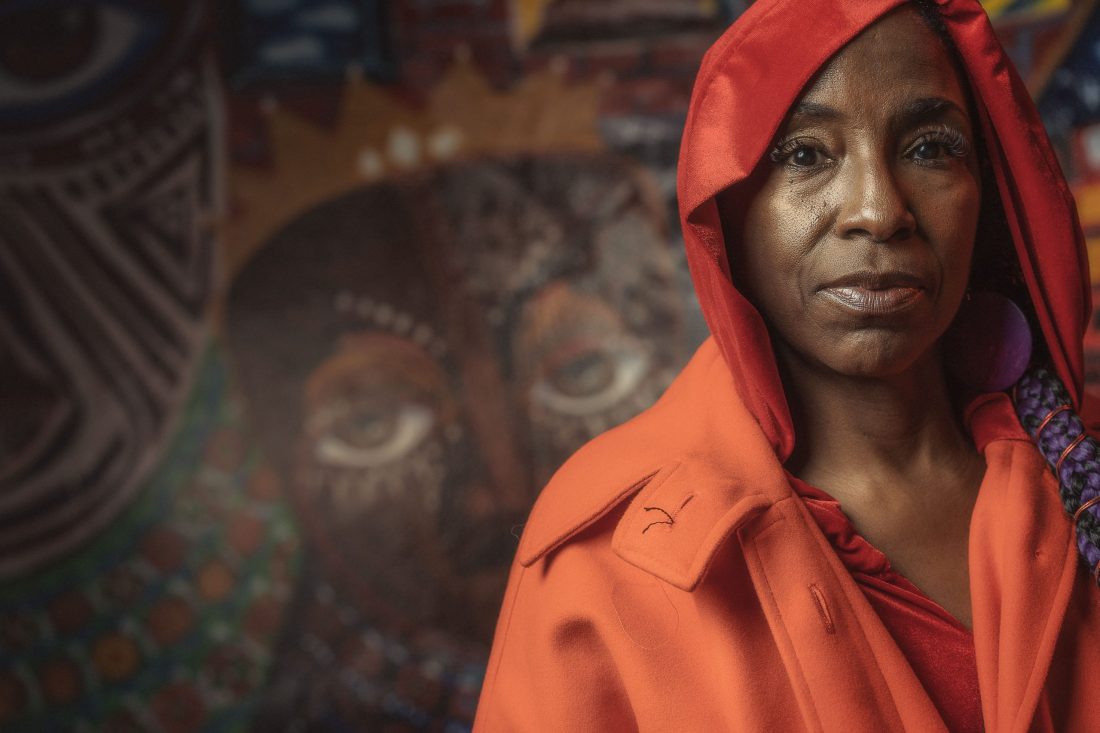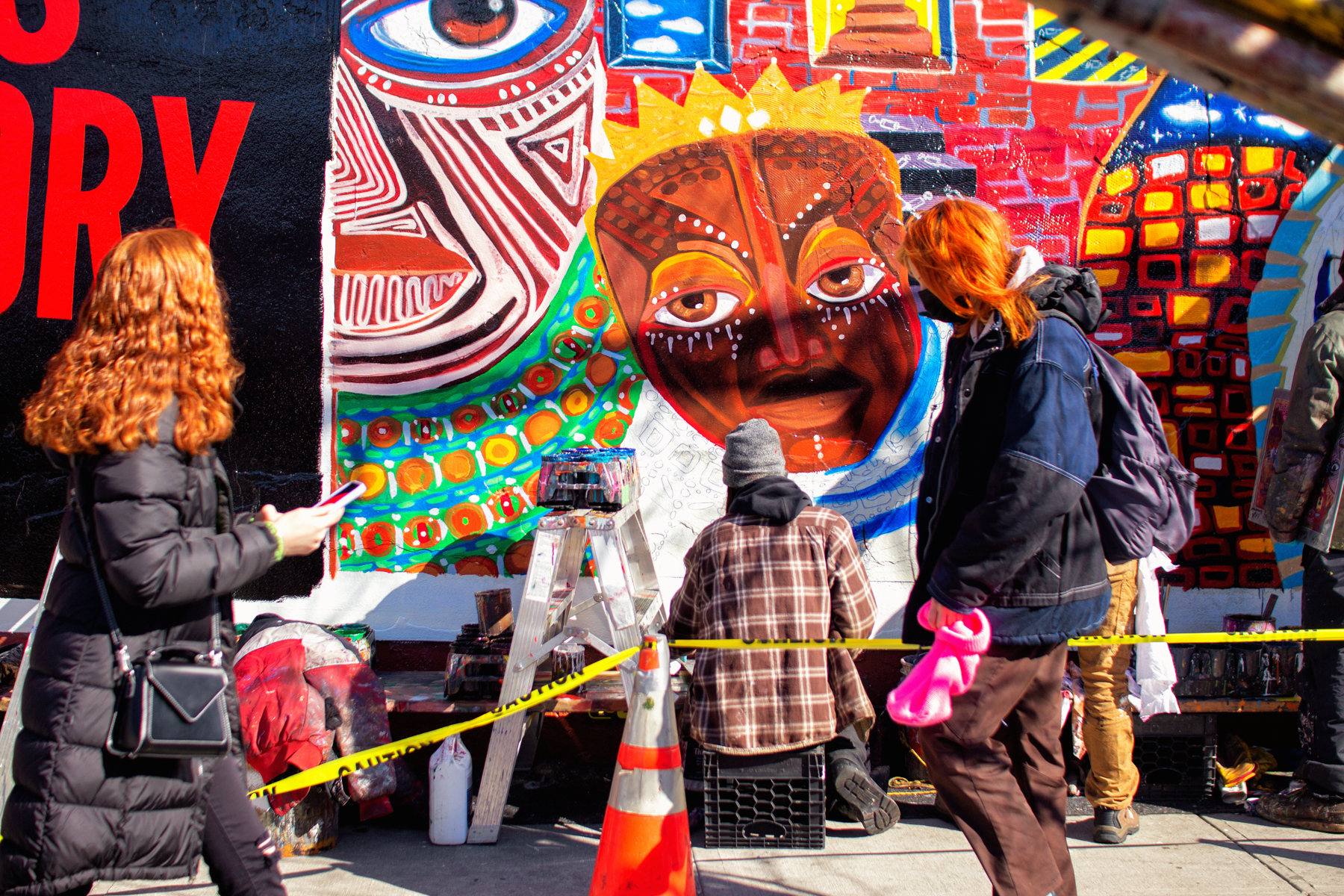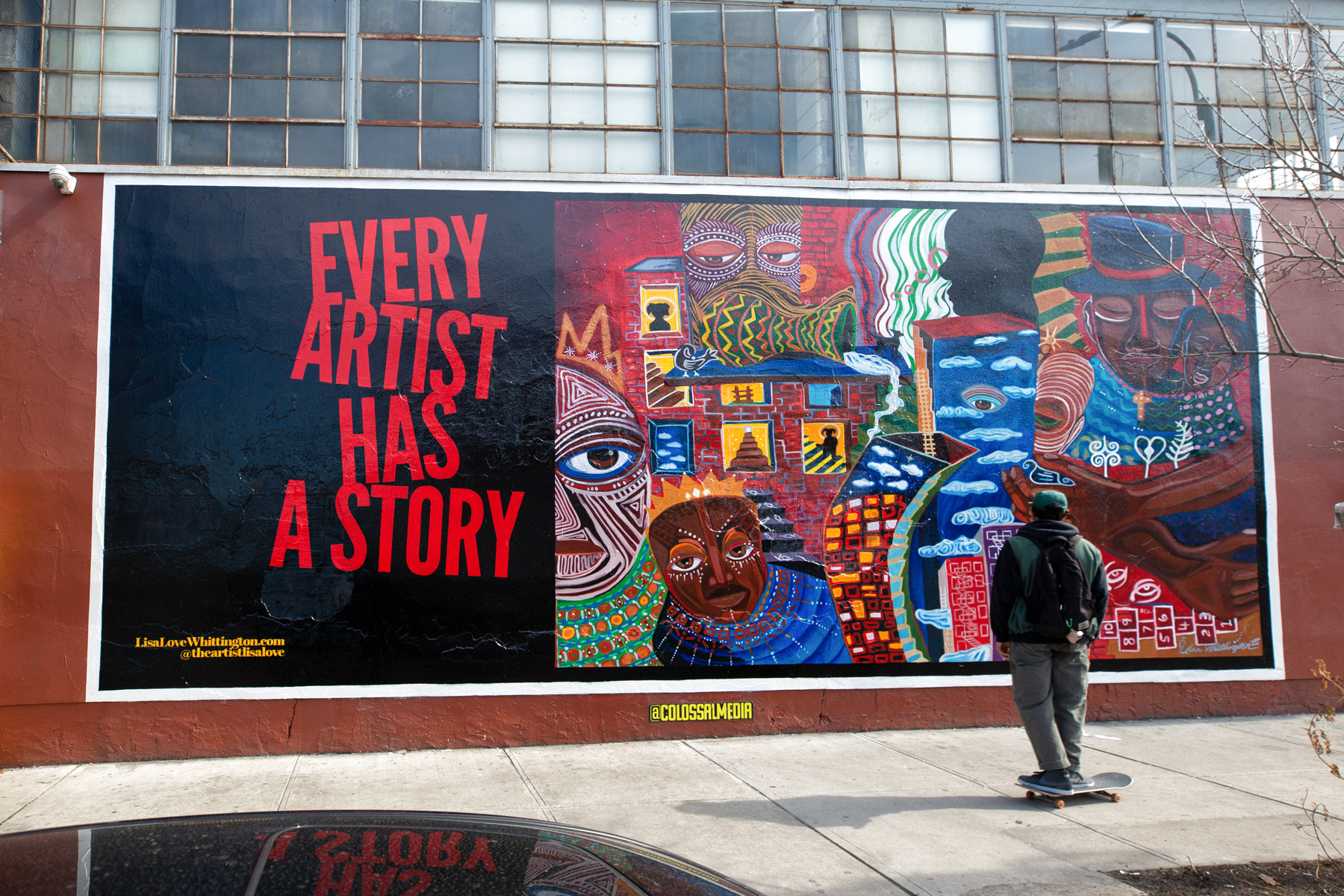Painting a Memoir
Lisa Whittington is a triumph of both grit and grace. As an artist and educator, Dr. Whittington engages personal narrative, political commentary, and cultural history in richly symbolic compositions. Her work is rooted in an empathetic awareness of her environment and bears witness to the Black American experience. This year, she introduced A Harlem Story to a Colossal wall in Bushwick, adapting intimate childhood memories to an impressive scale. We recently had the privilege of speaking with Dr. Whittington about her past, her process, and her power in art.

Portrait of Lisa Whittington.
New York City is the absolute greatest city in the world to be born and raised and have your humanity developed. New York is not just a place, it’s a bootcamp.
Lisa Whittington
You grew up in Harlem and your bio states, “New York instilled in her a rich sense of art, culture, experience, and drive, and taught her to dream and hustle to make her desires a reality.” Tell me a little bit about your upbringing and how it shaped you as an artist.
Lisa Whittington: What might seem to some to be a cycle of pitiful events was in fact the first steps of a beautiful journey. What I’ve learned on my journey is how places can shape you.
For me, that place was Harlem. I was a young child in Harlem, where my humanity was being formed and my senses were being developed. I was very shy and didn’t talk much, but I was naturally observant and I could feel things strongly. I could feel people. I could feel my surroundings, and I could feel what was in the air.
Even though I had never been to Africa, I knew what Africa felt like because of Harlem. Everything in Harlem was brown and rhythmic and strong and creative. When teachers would ask where I was born, with everything in me I would respond, “I was born in Africa.” Even though Harlem had problems with poverty, heroin, and race riots, there was still a sense of pride and determination that my young eyes could see in the eyes of Harlem’s people and the way light would shine on their skin.
This dignity overwhelmed me in ways that I had no words for as a child. It clothed me. Nina Simone’s music filled the airwaves and my soul. When her song “To Be Young, Gifted and Black” filled the air, suddenly there was nobody else in the room but just her and me. I would repeat those lyrics to myself until I owned them: To be young, gifted and Black/ Is where it’s at. The spirit of Harlem would shape, prepare, and strengthen me for the world that I would have to face as an African American. Throughout my years of living in Harlem, my senses became sharp and my spirit keen. I became an observer. I remember buses filled with white tourists visiting New York would come through Harlem, the passengers gawking like they were on a safari and we were the animals. And I would sit in the window, watching them watching us.
New York City is the absolute greatest city in the world to be born and raised and have your humanity developed. New York is not just a place, it’s a bootcamp. You learn to live with other people that don’t look like you and come from other parts of the world; you taste their food, sample their culture, and learn to live together. New York City provides a 101 in culture and diversity. It is the mecca for museums, entertainment, and the like. It’s basic training in the hustle: keep moving, make it work, figure it out, no excuses, succeed. Some of the world’s greatest artists, writers, and entertainers come from NYC. The towering list of artists that have come out of Harlem and impacted the world is astounding, phenomenal, and not by coincidence.

Your work is so expressive, filled with obvious and hidden narratives. Why is symbolism such a powerful tool for you?
LW: I love symbolism because symbolism adds details, produces impact without having to paint it outright. It also allows me to write a public diary in code. Symbolism can take you into the inner world and makes your canvas bigger. It adds interest, extends the story, and intrigues the viewer.
Your piece we painted in Bushwick, A Harlem Story, reads, “Every artist has a story.” Decode this work and tell me about the story here.
LW: A Harlem Story is full of symbolism. By creating this painting, I began writing a memoir in paint. A Harlem Story is the story of my life and the history of a place. The girl sitting in the window is me.
The Sankofa Bird symbolizes the importance of reaching back to the past and bringing it into the present to make positive progress. The many stairs and ladders embedded in the work signify to keep climbing. On the steps and near the hopscotch where the children played are empty heroin needles. Heroin needles were everywhere when I was in Harlem. I used to have to walk with my book bag up the stairs through a bunch of nodding junkies to get home. No harm ever came to me. Even though I felt lonely, I was never alone. I always felt there was someone watching over me, which is why there are so many eyes in the artwork.
The man holding the little girl is symbolic of my father (whom I never got to meet) holding me and praying over me, even though he was never able to find me or meet me. I believe he prayed a father’s prayer over me to protect and cover me. The adinkra symbols in his arms mean strength, courage, and God’s grace. The water and the clouds are spiritual symbols.
The dog on the roof represents a time when I used to have to go to the roof to walk the dog. The dog would lead me and we would hop from roof to roof of one building to another. One time, the dog miscalculated and there was no roof. The dog was dangling over the side of the building by the leash and with all my might I was pulling for his life, while trying not to let him make me fall eight flights down. By God’s grace, I managed to pull him up without falling off the roof.

My work is bigger than me. I understand this. Since the death of George Floyd, there has been a shift. It’s not just Black people that want a change anymore. White allies are telling other white people to “shut up and listen.”
Lisa Whittington
The past few years in this country have been full of creative awakenings and social reckonings. How have these events and movements impacted you and informed your work as a Black female artist?
LW: All of my degrees are in Art. I’ve been to museums all around the world. The more I learned, the less I realized I knew. But the one thing that I know for sure is that Art records history, and many artists have dual roles as creator and historian. When a viewer stands in front of an artwork, the question always arises: What is the artist trying to say? The years and the events that happened during the artist’s lifetime are examined and compared within the artwork, allowing future generations to make connections to history through the artist’s life. I understand this, and I’m thinking ahead and trying to leave evidence for future generations to piece together the history of Black people in America.
My work is bigger than me. I understand this. Since the death of George Floyd, there has been a shift. It’s not just Black people that want a change anymore. White allies are telling other white people to “shut up and listen.” I heard it myself and read it across social media. They are genuinely asking questions and trying to understand what Black people have been trying to express for years. It is because of an image that was shown that they were made aware of the experiences of Black people.
In the last year, I’ve had more inquiries into my work. Since the BLM movement started, two museums have added my work to their permanent collection. My work is a window into Black America and the history of a culture. One university took up a collection among their faculty to arrange a talk on their campus. They wanted me to present and discuss my work. The response after I finished speaking to a full house was, “We did not know.”

You’re a member of the Black Artists + Designers Guild, a Brooklyn-based collective we’re always proud to partner with. Why are professional communities like BADG so important to creatives?
LW: Professional organizations like the Black Artists and Designers Guild are important because it is a hub for Black creators to mingle, grind, discuss issues, receive encouragement, provide workshops, and share experiences. It’s also a place where our allies can find a collective of Black artists and creators on the move.
What’s next for you and your work?
LW: I’m excited about an artist residency that I have coming up at the Hambidge Center for Creative Arts in Georgia, where I will have the opportunity to focus on some new and very bold work. I also have some other exciting and interesting projects in the works.




